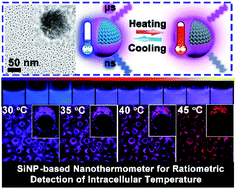Dual-emission fluorescent silicon nanoparticle-based nanothermometer for ratiometric detection of intracellular temperature in living cells†
Abstract
In this article, we present a kind of dual-emission fluorescent nanothermometer, which is made of europium (Eu3+)-doped silicon nanoparticles (Eu@SiNPs), allowing the detection of intracellular temperature in living cells with high accuracy. In particular, the presented SiNP-based thermometer features dual-emission fluorescence (blue (455 nm) and red (620 nm) emission), negligible toxicity (cell viability of treated cells remains above 90% during 24 h of treatment) and robust photostability in living cells (i.e., preserving >90% of fluorescence intensity after 45 min of continuous UV irradiation). More significantly, the fluorescence intensity of the Eu@SiNPs exhibits a linear ratiometric temperature response in a broad range from 25 to 70 °C. Taking advantage of these attractive merits, the Eu@SiNP-based nanothermometer is able to accurately (∼4.5% change per °C) determine dynamic changes in intracellular temperature in a quantitative and long-term (i.e., 30 min) manner.

- This article is part of the themed collection: Luminescent silicon nanostructures


 Please wait while we load your content...
Please wait while we load your content...